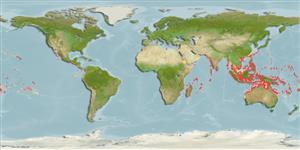Common names from other countries
>
Anguilliformes (Eels and morays) >
Muraenidae (Moray eels) > Muraeninae
Etymology: Gymnothorax: Greek, gymnos = naked + Greek, thorax, -akos = breast (Ref. 45335); fimbriatus: Named for Tamara Mikhailovna Ambrozhevich (Ref. 57775).
More on author: Bennett.
Environment: milieu / climate zone / depth range / distribution range
Écologie
marin; saumâtre récifal; profondeur 0 - 50 m (Ref. 90102). Tropical; 30°N - 28°S
Indo-Pacific: Madagascar (Ref. 33390) to the Society Islands, north to southern Japan (Ref. 559), south to Queensland, Australia; throughout Micronesia.
Taille / Poids / Âge
Maturity: Lm ? range ? - ? cm
Max length : 93.4 cm TL mâle / non sexé; (Ref. 121652); 87.2 cm TL (female); poids max. publié: 1.5 kg (Ref. 121652); poids max. publié: 1.5 kg
Vertèbres: 128 - 142. Adults pale with small black spots on face; black spots proportionally much larger in young (Ref. 30404).
Occurs in lagoons, reef flats and seaward reefs (Ref. 1602, 48635). Prefers protected inshore waters among dead corals, common in harbors and small caves (Ref. 30404). Probably nocturnal (Ref. 1602). Feeds on fishes and crustaceans (Ref. 9710). Possibly a protogynous hermaphrodite (Ref. 32169). Current age of a captive individual is 18 years, which exceeds 100 cm and approximately 10 lbs (owner Mark Palermo, pers. comm. 07/12). Minimum depth reported taken from Ref. 86942.
Life cycle and mating behavior
Maturities | Reproduction | Spawnings | Egg(s) | Fecundities | Larves
Protogyny unconfirmed (Ref. 84746).
Chen, H.-M., K.-T. Shao and C.T. Chen, 1994. A review of the muraenid eels (Family Muraenidae) from Taiwan with descriptions of twelve new records. Zool. Stud. 33(1):44-64. (Ref. 6934)
Statut dans la liste rouge de l'IUCN (Ref. 130435)
CITES (Ref. 128078)
Not Evaluated
Menace pour l'homme
Harmless
Utilisations par l'homme
Pêcheries: intérêt commercial mineur
Outils
Articles particuliers
Télécharger en XML
Sources Internet
Estimates based on models
Preferred temperature (Ref.
115969): 24.9 - 29, mean 28 (based on 774 cells).
Phylogenetic diversity index (Ref.
82804): PD
50 = 0.5000 [Uniqueness, from 0.5 = low to 2.0 = high].
Bayesian length-weight: a=0.00040 (0.00027 - 0.00059), b=3.31 (3.20 - 3.42), in cm Total Length, based on LWR estimates for this species & Genus-body shape (Ref.
93245).
Niveau trophique (Ref.
69278): 4.0 ±0.67 se; based on food items.
Résilience (Ref.
120179): Faible, temps minimum de doublement de population : 4,5 à 14 années (Preliminary K or Fecundity.).
Fishing Vulnerability (Ref.
59153): High vulnerability (57 of 100).
